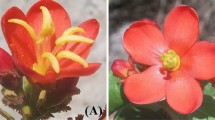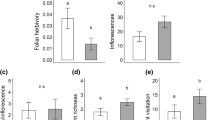Abstract
Elucidating the factors determining the occurrence of florivorous organisms is an essential step for comprehending arthropod–plant interactions, especially when considering florivores that use flowers/inflorescences as microhabitats. In this study, we characterize the interaction between florivorous thrips (Thysanoptera) and Palicourea rigida (Rubiaceae), a distylous hummingbird-pollinated shrub. We investigated the relative role of different factors in determining thrips occurrence in the flower and inflorescence microhabitats. Furthermore, we experimentally examined the protective role of corolla influencing thrips exploration of floral buds. Frankliniella musaeperda (Thripidae) was the only species recorded on P. rigida, feeding on floral tissue, pollen and nectar. Thrips occurrence was not related to distyly, but rather to floral stage. Open flowers presented the highest abundance of thrips, followed by senescent flowers and then buds. The experimental opening of buds translated in increased thrips occurrence, indicating that F. musaeperda manage to explore the microhabitat offered by the floral chamber, as long as there is an opening in the corolla. In inflorescences, thrips abundance was negatively related to the number of ants visiting extrafloral nectaries. We found that the marked difference between floral morphs of distylous plants is not necessarily reflected in the abundance of florivores. Thrips seek for floral cavities, preferentially those with fresh tissue, which may confer nutrient-rich food and protection. Buds also provide this; however, the enclosed petals are an effective barrier against F. musaeperda entrance. At inflorescence scale, presence of mutualistic ants in high numbers can drive away these flower-feeding insects. Despite the abundance of thrips in the flowers, there was no evidence of any functional relationship, either of pollination for flowers or of breeding for insects. We demonstrate here that in the flower/inflorescence microhabitat, structural and biotic factors play a key role in the exploitation and occupation by insect florivores.



Similar content being viewed by others
References
Altmann J (1974) Observational Study of behavior: sampling methods. Behaviour 49:227–267. doi:10.1163/156853974X00534
Alves-Silva E, Del-Claro K (2010) Thrips in the Neotropics: What do we know so far? Trends Entomol 6:77–88
Alves-Silva E, Del-Claro K (2014) Fire triggers the activity of extrafloral nectaries, but ants fail to protect the plant against herbivores in a neotropical savanna. Arthropod Plant Interact 8:233–240. doi:10.1007/s11829-014-9301-8
Alves-Silva E, Del-Claro K (2016) On the inability of ants to protect their plant partners and the effect of herbivores on different stages of plant reproduction. Austral Ecol 41:263–272. doi:10.1111/aec.12307
Alves-Silva E, Maruyama PK, Cavalleri A, Del-Claro K (2013) Flower stage and host plant preference by floral herbivore thrips (Insecta: Thysanoptera: Frankliniella) in a Brazilian savanna. Stud Neotrop Fauna Environ 48:25–31. doi:10.1080/01650521.2012.751785
Bates D, Maechler M, Bolker B, Walker S, Christensen RHB, Singmann H et al (2014) Package ‘lme4’. R Foundation for Statistical Computing, Vienna
Burgess KH (1991) Florivory: the ecology of flower feeding insects and their host plants. Ph.D. Thesis, Harvard University, Cambridge, MA
Cavalleri A, Mound LA (2012) Toward the identification of Frankliniella species in Brazil (Thysanoptera, Thripidae). Zootaxa 3270:1–30
Chen Y, Williams KA (2006) Quantifying western flower thrips (Frankliniella occidentalis Pergande) Thysanoptera:Thripidae) damage on Ivy Geranium (Pelargonium peltatum (L.) L’Her ex Ait.) (Geraniaceae Juss.) with Adobe® Photoshop™ and Scion® Image Software. J Kansas Entomol Soc 79:83–87. doi:10.2317/0022-8567(2006)079[0083:QWFTFO]2.0.CO;2
Contreras PS, Ornelas JF (1999) Reproductive conflicts of Palicourea padifolia (Rubiaceae) a distylous shrub of a Tropical cloud forest in Mexico. Plant Syst Evol 219:225–241. doi:10.1007/BF00985581
de Souza ALB, Delabie JHC, Fowler HG (1998) Wasmannia spp. (Hym., Formicidae) and insect damages to cocoa in Brazilian farms. J Appl Entomol 122:339–341. doi:10.1111/j.1439-0418.1998.tb01509.x
Del-Claro K, Guillermo-Ferreira R, Almeida EM, Zardini H, Torezan-Silingardi HM (2013) Ants visiting the post-floral secretions of pericarpial nectaries in Palicourea rigida (Rubiaceae) provide protection against leaf herbivores but not against seed parasites. Sociobiology 60:217–221. doi:10.13102/sociobiology.v60i3.217-221
Dinno A (2015) dunn.test: Dunn’s test of multiple comparisons using rank sums. R package version 1.2.3. http://CRAN.R-project.org/package=dunn.test
Escarré JE, Lepart J, Sentuc JJ (1996) Effects of simulated herbivory in three old field Compositae with different inflorescence architectures. Oecologia 105:501–508. doi:10.1007/BF00330013
Frame D (2003) Generalist flowers, biodiversity and florivory: implications for angiosperm origins. Taxon 52:681–685. doi:10.2307/3647343
Geddes NA, Mopper S (2006) Effects of environmental salinity on vertebrate florivory and wetland communities. Nat Areas J 26:31–37. doi:10.3375/0885-8608(2006)26[31:EOESOV]2.0.CO;2
Irwin RE, Adler LS (2006) Correlations among traits associated with herbivore resistance and pollination: implications for pollination and nectar robbing in a distylous plant. Am J Bot 93:64–72. doi:10.3732/ajb.93.1.64
Irwin RE, Brody AK, Waser NM (2001) The impact of floral larceny on individuals, populations, and communities. Oecologia 129:161–168. doi:10.1007/s004420100739
Justino DG, Maruyama PK, Oliveira PE (2012) Floral resource availability and hummingbird territorial behaviour on a Neotropical savanna shrub. J Ornithol 153:189–197. doi:10.1007/s10336-011-0726-x
Kindt F, Joosten NN, Peters D, Tjallingii WF (2003) Characterisation of the feeding behaviour of western flower thrips in terms of electrical penetration graph (EPG) waveforms. J Insect Physiol 49:183–191. doi:10.1016/s0022-1910(02)00255-x
Kirk DJ (1987) How much pollen can thrips destroy? Ecol Entomol 12:31–40. doi:10.1111/j.1365-2311.1987.tb00982.x
Kirk WD (1997) Feeding. In: Lewis T (ed) Thrips as crop pests. CAB International, Oxon, pp 65–118
Kottek M, Grieser J, Beck C, Rudolf B, Rubel F (2006) World Map of the Köppen-Geiger climate classification updated. Meteorol Z 15:259–263. doi:10.1127/0941-2948/2006/0130
Lawton JH (1983) Plant architecture and the diversity of phytophagous insects. Annu Rev Entomol 28:23–39. doi:10.1146/annurev.en.28.010183.000323
Leege LM, Wolfe LM (2002) Do floral herbivores respond to variation in flower characteristics in Gelsemium sempervirens (Loganiaceae), a distylous vine? Am J Bot 89:1270–1274. doi:10.3732/ajb.89.8.1270
Lima TA, Pinto JRR, Lenza E, Pinto AS (2010) Florística e estrutura da vegetação arbustivo-arbórea em uma área de cerrado rupestre no Parque Estadual da Serra de Caldas Novas, Goiás. Biota Neotrop 10:159–166. doi:10.1590/S1676-06032010000200020
Lima EFB, Monteiro RC, Zucchi RA (2013) Thrips species (Insecta: Thysanoptera) associated to Fabaceae of agricultural importance in Cerrado and Amazon-Caatinga ecotone from Brazilian mid-North. Biota Neotrop 13:283–289. doi:10.1590/S1676-06032013000200027
Machado AO, Silva AP, Consolaro H, Barros MAG, Oliveira PE (2010) Breeding biology and distyly in Palicourea rigida H. B. and K. (Rubiaceae) in the Cerrados of Central Brazil. Acta Bot Bras 24:686–696. doi:10.1590/S0102-33062010000300012
Maruyama PK, Oliveira GM, Ferreira C, Dalsgaard B, Oliveira PE (2013) Pollination syndromes ignored: importance of non-ornithophilous flowers to Neotropical savanna hummingbirds. Naturwissenschaften 100:1061–1068. doi:10.1007/s00114-013-1111-9
McCall AC, Irwin RE (2006) Florivory: the intersection of pollination and herbivory. Ecol Lett 9:1351–1365. doi:10.1111/j.1461-0248.2006.00975.x
Milne JR, Walter GH, Kaonga D, Sabio GC (1996) The importance of non-pollen plant parts as food sources for the common blossom thrips, Frankliniella schultzei. Entomol Exp Appl 78:271–281. doi:10.1111/j.1570-7458.1996.tb00791.x
Moog U, Fiala B, Federle W, Maschwitz U (2002) Thrips pollination of the dioecious ant plant Macaranga hullettii (Euphorbiaceae) in Southeast Asia. Am J Bot 89:50–59. doi:10.3732/ajb.89.1.50
Mound LA (2013) Homologies and host-plant specificity: recurrent problems in the study of thrips. Fla Entomol 96:318–322. doi:10.1653/024.096.0250
Mound LA, Marullo R (1996) The thrips of Central and South America: an introduction (Insecta: Thysanoptera). Associated Publishers, Gainesville, Florida
Mound LA, Terry I (2001) Thrips pollination of the central Australian cycad, Macrozamia macdonnellii (Cycadales). Int J Plant Sci 162:147–154. doi:10.1086/317899
Northfield TD, Paini DR, Funderburk JE, Reitz SR (2008) Annual cycles of Frankliniella spp. (Thysanoptera: Thripidae) thrips abundance on north Florida uncultivated reproductive hosts: predicting possible sources of pest outbreaks. Ann Entomol Soc Am 101:769–778. doi:10.1093/aesa/101.4.769
Oguro M, Sakai S (2009) Floral herbivory at different stages of flower development changes reproduction in Iris gracilipes (Iridaceae). Plant Ecol 202:221–234. doi:10.1007/s11258-008-9461-7
Peng RK, Christian K (2004) The weaver ant, Oecophylla smaragdina (Hymenoptera: Formicidae), an effective biological control agent of the red-banded thrips, Selenothrips rubrocinctus (Thysanoptera: Thripidae) in mango crops in the Northern Territory of Australia. Int J Pest Manag 50:107–114. doi:10.1080/09670870410001658125
Pettersson MW (1991) Flower herbivory and seed predation in Silene vulgaris (Caryophyllaceae): effects of pollination and phenology. Holarct Ecol 14:45–50. doi:10.1111/j.1600-0587.1991.tb00632.x
Sakai S (2001) Thrips pollination of androdioecious Castilla elastica (Moraceae) in a seasonal tropical forest. Am J Bot 88:1527–1534. doi:10.2307/3558396
SEMARH—Agência Ambiental de Goiás (2015) Parque Estadual da Serra de Caldas Novas (PESCaN). http://www.semarh.goias.gov.br/site/conteudo/parque-estadual-da-serra-de-caldas-novas-pescan. Accessed 7 Feb 2015
Sowell DR, Wolfe LM (2010) Pattern and consequences of floral herbivory in four sympatric Ipomoea species. Am Midl Nat 163:173–185. doi:10.1674/0003-0031-163.1.173
Strauss SY (1997) Floral characters link herbivores, pollinators, and plant fitness. Ecology 78:1640–1645. doi:10.1890/0012-9658(1997)078[1640:FCLHPA]2.0.CO;2
Strauss SY, Irwin RE (2004) Ecological and evolutionary consequences of multi-species plant-animal interactions. Annu Rev Ecol Evol Syst 35:435–466. doi:10.1146/annurev.ecolsys.35.112202.130215
Taylor CM (1997) Conspectus of the genus Palicourea (Rubiaceae: Psychotrieae) with the description of some new species from Ecuador and Colombia. Ann Mo Bot Gard 84:224–262. doi:10.2307/2400003
R Core Team (2015) R: a language and environment for statistical computing. R Foundation for Statistical Computing, Vienna, Austria. http://www.R-project.org/
Teixido AL, Méndez M, Valladares F (2011) Flower size and longevity influence florivory in the large-flowered shrub Cistus ladanifer. Acta Oecol 37:418–421. doi:10.1016/j.actao.2011.05.007
Valtueña FJ, Ortega-Olivencia A, Rodríguez-Riaño T, Pérez-Bote JL, Mayo C (2013) Behaviour of pollinator insects within inflorescences of Scrophularia species from Iberian Peninsula. Plant Biol 15:328–334. doi:10.1111/j.1438-8677.2012.00644.x
Wardhaugh CW (2015) How many species of arthropods visit flowers? Arthropod Plant Interact 9:547–565. doi:10.1007/s11829-015-9398-4
Wyatt R (1982) Inflorescence architecture: how flower number, arrangement, and phenology affect pollination and fruit set. Am J Bot 69:585–594. doi:10.2307/2443068
Zuur AF, Ieno EN, Walker NJ, Saveliev AA, Smith GM (2009) Mixed effects models and extensions in ecology with R. Springer, New York
Acknowledgments
We are grateful to Flávio Camarota for ant species identification. We also thank three anonymous referees for providing comments that improved the manuscript. PKM receives founding from the São Paulo Research Foundation (FAPESP Proc. 2015/21457-4). Ant and spider specimens were deposited in the Laboratório de Ecologia e Comportamento de Abelhas, Universidade Federal de Uberlândia, Brazil.
Author information
Authors and Affiliations
Corresponding author
Additional information
Handling Editor: Stanislav Gorb.
Rights and permissions
About this article
Cite this article
Cardoso, J.C.F., Gonzaga, M.O., Cavalleri, A. et al. The role of floral structure and biotic factors in determining the occurrence of florivorous thrips in a dystilous shrub. Arthropod-Plant Interactions 10, 477–484 (2016). https://doi.org/10.1007/s11829-016-9443-y
Received:
Accepted:
Published:
Issue Date:
DOI: https://doi.org/10.1007/s11829-016-9443-y




